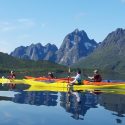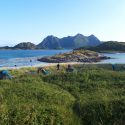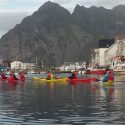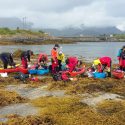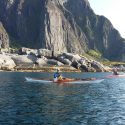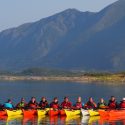The Cadet Centre for Adventurous Training planned, organised and executed a huge logistical undertaking to move its entire sea kayaking fleet and equipment overland from Capel Curig, North Wales to a base in the Lofoten Islands, Northern Norway. An advance party of three travelled overland for three and a half days across Europe and up the spine of Norway crossing into the Arctic circle with the essential equipment. A mixed team of students (9 x senior cadets and 3 x CFAVs) accompanied by 2 x additional instructors took two flights and a whole day to finally meet up with the advance team on Sun 18 August 2019.
All the participants had been on an introductory CCAT sea kayaking course before, either in Scotland or North Wales, as a prerequisite to attending this expedition. This was a unique first for the Cadets organisation firstly as a sea kayak expedition and secondly to experience the Lofoten archipelago. There had been a mass of applications for the limited spaces on the expedition so these were the ‘chosen few’ and they were all very grateful and excited for the opportunity.
After a hearty breakfast the team assembled on the pier overlooking the crystal clear fjord, high mountains under a cloudless sky for the team briefing. Being in the Arctic circle this was somewhat of a pleasant surprise to be sat in such a stunning arena in just shorts and a T-shirt. Major Edwards presented an overview of the outcomes during the 10-day expedition as well as a broad brush picture of where they were in the world. Once the specialist equipment had been issued and fitted correctly the initial training began in earnest. Lofoten kayaking began with a capsize in the first 30 seconds and a pair of lost sunglasses. After that minor blip, the team undertook a complete refresher on the essential skills that were going to be crucial to the success of the expedition as well as learning more advanced techniques whilst developing our confidence on the water. Our first journey out of the bay was accompanied by a bloom of pink moon jellyfish and the panic that we would get stung; we did not and Ali picked one up to show it was harmless. However under no circumstances were we to touch the lion’s mane jellyfish! Rock hopping was introduced which tested people’s calmness under pressure as the swell provided some exciting surprises. Comfort zones were again stretched when the rescue practice began, which involved full submersion in the clear but cold arctic water. This skills session gelled the team as this was the first day of working together. Trust was quickly realised during the balance games which had everyone laughing. A crowd of onlookers gathered to see what the hilarity was about as we tried to rub noses with our kayak, sit on the back and standup with numerous spectacular shapes being made as people parted company with their boat, including instructors, and fell in the water.
After the previous day’s activities that reacquainted us with the sea kayaks our first day trip took us outside the bay of our campsite from, Sandvika to Henningsvaer. This was our first glimpse of the vastness of this part of Norway. Mink playing on the shoreline and golden eagles accompanied us on our journey. We split into two groups, starting at opposite ends of the trip. Clouds covered the tops of the mountains immersing us into a fairytale land. With a light swell and low winds the journey started gently with rock hopping and spectacular views. The two groups briefly reunited to share stories from their morning, before powering on to their final destination. A short lunch stop in picturesque fishing village at Henningsvaer allowed us to experience the culture of the Norwegen people. The 19km kayak trip gave us a mouth-watering taster which made the anticipation for the next few days even greater.
A stormy day followed with force 6 winds battering the coastline. The prospect of this arctic weather was met with great dismay, despite the enthusiasm of the staff. However undeterred training continued and the mood completely lifted after a very competitive game of “Stuck in the mud” on the beach. Paddle after paddle, the kayak shifted through the clear water, surprisingly warm in the cold weather, the winds were strong and the waves were short, sharp and steep on the fjord and constant battles waged against the conditions which included a full on squall making you continuously blink as we paddled into the force of the wind and the rain. Apprehensive at first, we tensely and nervously edged from flat, reasonably calm shelter expecting to hit a maelstrom type effect of wind along with metre high waves which felt like they were throwing the boats everywhere. A few tentative exercises to get used to the conditions edging out of shelter then darting back and after a couple of strokes, we could relax and enjoy the final downwind blast back to the beach with grins as we caught the occasional wave. This day on the water had been a harsh lesson of dealing with the elements. Althpough this was a shorter paddling day the time was used for presentations on tides and weather as well as preparing for the 3-day (2- overnight) self-sufficient expedition. We finished the day with food shopping for our 3-day expedition rations which would all have to be packed into our sea kayaks so planning the menus required some careful thought.
The 3 day remote wilderness expedition commenced in the deep fjords around Raftsundet, east of Svolvaer. We launched in slightly stronger winds than forecast as two teams with different objectives. One heading deep into the mountainous terrain to enter the evocatively named Trollfjord and the other staying more seaward with their objective being the circumnavigation of ‘Moose island’ or Lille Molla as it is marked on the map. Excitement was bubbling within the groups as they packed their boats for 3 days travelling and living out of them, a unique experience and something eagerly anticipated. Serious decisions and judgement was evident before even leaving the beach as both teams surveyed the first 100m that need to be negotiated, there were no breaking seas but there were certainly some significant swell on the ocean! The first group across ran into 1.5 swell after 500m and stayed close together, which is a testament to the skill they had developed, the force 5 wind was definitely focusing the mind. George admitted he found this part really tough and was worried he would not be able to complete the 3 days due to the energy he was using. As the outer islands of Oddvaer were reached the team paddled into calmer water with obvious looks of relief exchanged amongst the group. The rest of the journey to Trollfjord was thoroughly enjoyed as the wind and tide carried the team to their campsite. The other team crossed higher up with the intention of making a second crossing to just north of LIlle Molla, the experience of the first crossing shared with the other team and the prospect of the second, but longer, one had the team making alternative plans as energy levels and the sea state made the second crossing untenable. The team followed the previous group up for a while before deciding to set camp mid-afternoon. Real grit, determination and teamwork was needed as well as each person drawing on the depths of their reserves as, already tired from paddling, they set up tents in driving rain whilst trying to keep everything as dry as possible. It was this experience that had Lauren recalibrate as to what wild camping really can be! The other team struggled to find a campsite as the information from the guidebook continued to show itself as being pretty vague. Several landings and inspections finally brought them to camp in the garden of a deserted but fully furnished house with a lone gravestone. With winds easing and a welcome meal the team launched once more to go and explore the evocative Trolford with its huge steep rock walls making everyone feel very small against such a dramatic backdrop. Waterfalls where the group donned helmets, pulled up hoods and paddled under the icy needles of cold water. Harry had taken the water carriers with him and bravely filled them whilst being bombarded by the very fresh water cascading from some 150m above him.
What a difference a day makes with the winds dying down completely overnight, the low brooding cloud of the day before giving way to bright sunshine allowing both teams to launch into a vast landscape on a calm, glassy sea. The group that had aborted its crosing the day before slid across clam water and headed south to cicumnavigate Lille Molla.
The other group delayed their departure so as to arrive at a nearby cafe set in a small hamlet by a ferry terminal, the beauty of google maps. The owner was very pleased to see us as we had a ‘second breakfast’ of freshly made waffles (limited menu – waffles or waffles) which we all ordered along with coffee and tea. After this the team made good progress along the opposite shore of Stormolla accompanied by sea eagles. Henry was struck by the weight of silence that surrounded us at times with it being one of the most awe inspiring places he has been. Both groups met up to the north of Lille Molla and spent time together swapping stories before heading off to find a campsite. Like the day before, this was harder than expected and on the fifth attempt a suitable camping spot was found. A huge uplift in morale as once through the long grass beyond the beach a flat area complete with a previously made stone fire pit was found which housed the tents comfortably. The team clubbed together seamlessly as the work of setting camp, cooking and lighting a fire was performed without fuss showing how the team had molded together into a symbiotic unit.
The final day of the expedition had another change in the weather with light winds creating a small amount of sea state for the open crossing past Svolvaer and back to base camp some 18km away. Tired bodies with aches and pains had little time to warm up and the initial crossing felt tedious with little chat as each team member had to dig deep to complete the journey. Rock hopping opportunities presented themselves and provided a distraction to just paddling forwards, Harry found himself in some ‘interesting’ swell at one point and did really well to stay up and get back out.. After 3 days in a boat, 80km paddled and the mindset of being on expedition again the various individuals had to draw on deeper energy reserves to complete the tasks as well as encouraging each other.
Team 1s ‘pack of cards’ from the expedition:
Heart (thing they most enjoyed) – Trollfjord and getting to the second campsite, expectation versus reality.
Club (where they clubbed together) – Setting up the second campsite, sorting tents, cooking, lighting a fire and generating positive morale after two tiring days.
Spade (where the team had to dig in) – Getting the crossing done on the last day, everyone was aching with low energy levels and it took time for folk to ‘warm up’. The mental challenge both individually and as a group.
Diamond (the expedition diamond geezer) – two of them – Joe for his effort on the first day in leading the group on the water and directing the campsites activities. Jacob is the other for always being positive and proactive both on the water and on land.
Team 2s ‘pack of cards’ from the expedition:
Heart – The trip continually exceeded expectations, beautiful scenery, white beaches, blue sea.
Club – Working together to put up tents and cook meals no matter what the weather, even when we were soaked through, it really made us work together.
Spade – a drop in morale for not seeing any moose on Moose Island, requiring a lifting of spirits. On the final morning the team were tired, sore and bruised and not enthused about the prospect of the crossing to the pick-up point.
Diamond – Oli for his strength and also his continuous ability to keep morale up.
‘Surfs up dude’ – was a day of learning to surf in sea kayaks. The forecast was great with 1mts waves predicted. The general consensus was that everyone was ’psyched but apprehensive as up to 1m waves speed with some force over a 50m break. First moves were tentative with a fair few wipeouts and folk arriving at the beach not necessarily with their kayak and paddle. A determined approach was found to be successful with many enjoying the paddle out as you went over a breaking wave and crashed down the other side. The group split into two with half surfing and the other half on the beach to provide safety support. Many commented on how grateful they were to have a beach buddy whose job it was to be on the shore and just point folk back out into the surf once they had ridden in. Surfing is tiring and after 3 hours of riding some quite meaty waves the group were exhausted but incredibly satisfied with being able to take full advantage of the rare conditions that had appeared on the beach that day. Lauren in particular gained a huge amount from the day having been battered in the initial stage, she showed great resilience and eventually rode a wave in very skillfully which resulted in a huge beaming smile and, in her words, ‘ a massive sense of achievement’.
Another change in dynamic saw the group using a tidal jet of water under a bridge to see how the sea kayaks performed in what was essentially a white water environment. A broad range of experiences in the group in this environment with some taking their first strokes and others having been on this type of fast flowing, dynamic water before. Those new to the activity started lower down the flow where it had a gentler feel with those with experience starting in the confused foam under the bridge and having their paddle taken away so just having their hands for propulsion. Both Joe and Jacob who had quite a bit of previous experience said they found this really challenging due to the longer boat and lack of balance, Joe even performed an impressive hand roll at one point. Needless to say, rescue skills were practiced fairly frequently at the beginning, but as the team started to relax and genuinely encouraged each other, smoother and more fluid performance became the norm with the now associated grins and sense of achievement. Henry was 18 today and he performed his first successful kayak roll and was quite simply jubilant.
The Lofoten archipelago is split into the inside and outside areas; the inside being the southern coast which has greater shelter from the prevailing weather with the outside being the northern coast and and thus fully open to the force of the sea. We had spent all our time on the inside of the islands but the forecast and sea state on our last day of paddling gave the opportunity to paddle on the outside. This was exciting for all of us as we paddled out of the sheltered harbour of Lauvik in the sunshine to be met by a long rolling swell which broke impressively on the shore but gave a rolling ride. It was somewhat bizarre to think we had the Norwegian Sea to our left and front with the Barents Sea and Russia not that far in seamanship terms to our right. This really brought home how far north we were on the planet, particularly as when looking north the next landmass is Svalbard and then the Arctic with the left being Greenland with us being well above Iceland. This final day of paddling was again a contrast with the significant but long swell of the outside of the islands but once inside the smaller islands a flat calm sea with visibility which made you feel like you were flying at times. We paddled through a nature reserve in the hopes of seeing seals, which sadly did not appear, but again were graced with the sight of sea eagles with soaring mountains as a backdrop to their graceful flight. Most of the group had achieved the British Canoeing Sea Kayak Award by this point with only a couple needing to perform a deep water rescue of self and then a peer. After 9 days of activity and the associated aches and energy levels, this was a draw on reserves and Becky in particular showed stoic determination in getting herself back into her boat before then helping a peer into theirs. The end result was eleven of the participants achieved the award which was a first for CCAT.
The work involved in the planning and organising this expedition was greatly appreciated and particularly the financial support from the Ulysses Trust giving us this unique opportunity.
Final statements from the group:
Teal: “Looking up and seeing the dramatic landscapes and making friends along the way has been more than I thought it would be.”
TealJacob: “There’s not a word to describe this trip, I cannot begin to quantify it.”
George: “Rolling for the first time. An amazing place, the changes from the clam of a perfectly windless day to a full on arctic storm the next day.”
Harry: “Epic, came searching for an adventure and got one. The 3 day expedition, the nature reserve all felt like it was from the tv.”
Mike: “The people, variety and scale of the place. Never been anywhere like this! Pushing myself through F5 winds to the liquid skies of the last day.”
Henry: “Absolute perfection the whole trip, the challenges, new skills and people I’ve shared them with.”
Joe: “Second night campfire on the exped after my pee with a view, I thought, wow! Look where I am and what I am doing and with these people.”
Rachel: “As a geographer, seeing the scenery change everyday.”
Lauren: “Before the expedition I was very nervous, three weeks ago I would not have believed all the things I have achieved here.”
Oli: “Scenery is amazing as well as the people we have paddled with.”
Heather: “First few days I could not believe I was actually here with a group that bonded so well.”
Rebecca: “From nervous having never been in a sea kayak but grasping the opportunity and achieving so much more than I thought possible.”
| Serial | Statistic | Total |
| 1 | KMs paddled | 224 |
| 2 | KMs on Expedition | 122 |
| 3 | Individual tent nights | 30 |
| 4 | British Canoeing Sea Kayak Awards Passed | 11 |
| 5 | Sea Eagles seen | 18 |
| 6 | Golden Eagles seen | 7 |
| 7 | Moose seen | 3 |
| 8 | Otter seen | 1 |
| 9 | Mink seen | 3 |
| 10 | Stoats seen | 3 |
The Ulysses Trust also wish to thank the generosity of the Army Sport Control Board for supporting this expedition britisharmysport.com

